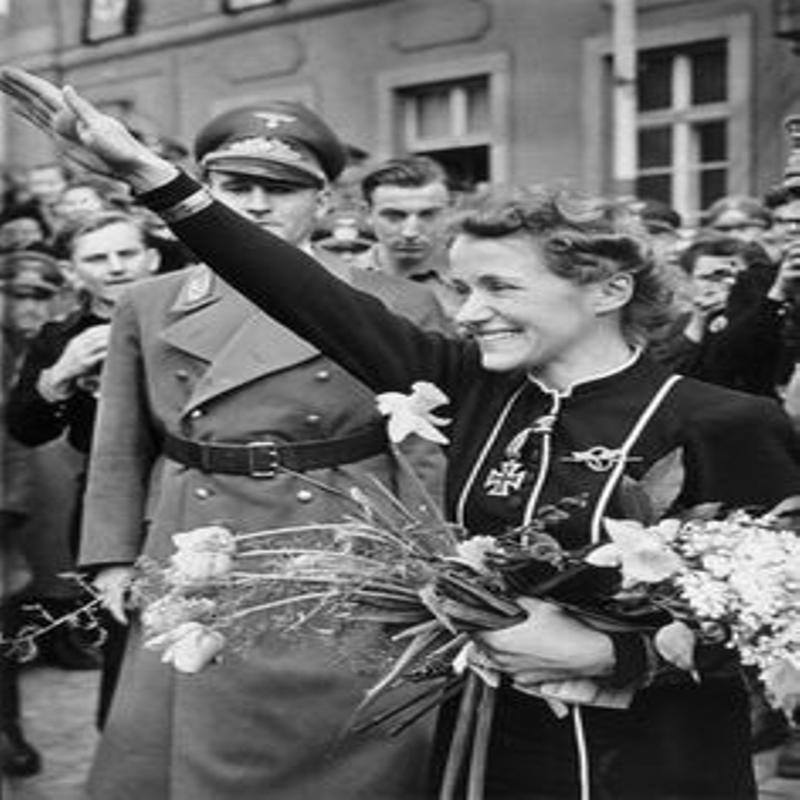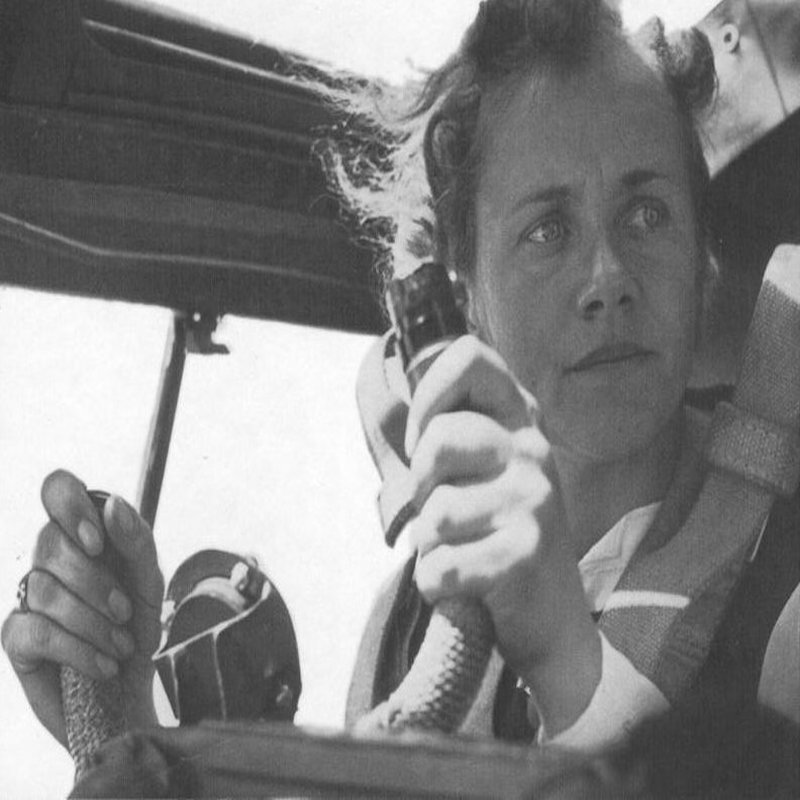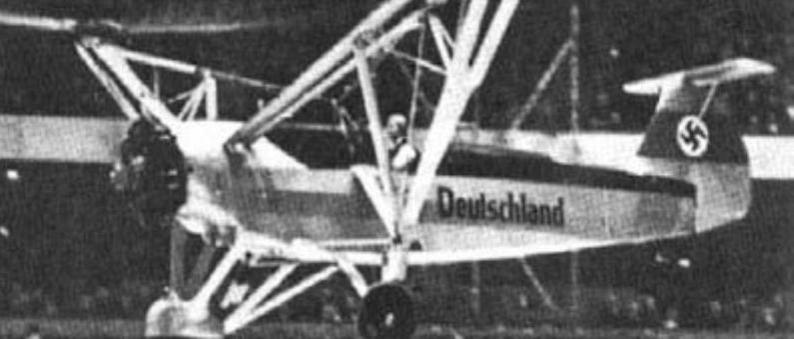Hanna Reitsch: Nazi Test Pilot
Posted on 7th January 2021
Unlike female flyers in the Soviet Union Hanna Reitsch never flew a combat mission but then as Nazi Germany’s premier Test Pilot she was never expected to. Even so, the dangers she faced and the risks she took were no less demanding and no less real. Of course, it was never expected that she should fly at all. Born in Hirschberg, Silesia, in 1912 into a prosperous middle class family, her father, a doctor, expected her to follow in his footsteps.
In this regard she didn’t disappoint studying medicine at Kiel University, but it was never really her passion, that was flying and it had been ever since she first attended the Gliding School at nearby Grunau. For a time she tried to combine the two becoming a flying doctor in Africa but before long she was back in Germany where her love of flying became all-consuming and it wasn’t long before she broke the endurance record for a glider pilot remaining in the air for over five hours.

Her ability was soon recognised and in 1933 she abandoned her medical studies to become a Glider Instructor in Homburg where she continued to break records making the longest flight undertaken in a glider and becoming the first woman to successfully fly over the Alps.
Hanna’s growing reputation as an aviator also coincided with the Nazi’s rise to power and the formation of the Luftwaffe in 1934. Forbidden to have an Air Force under the terms of the Versailles Treaty for a time its future pilots were trained at Glider Schools. It was Hanna’s first involvement with the military, and she was to formally enlist as a Test Pilot three years later when she would become one of the first people to fly the recently constructed Juncker and Dornier Bombers. Indeed, there were few designs or concepts in aerial warfare developed in Germany that she was not to be involved in.
Women had a very specific role in Nazi Germany, they were expected to be mothers and homemakers and very little else. Unorthodoxy was frowned upon, but exceptions could be made where it was seen to benefit the interests of the State and the Minister for Propaganda Joseph Goebbels knew an opportunity when he saw one. Hanna Reitsch was fair-haired, blue-eyed, and athletic the very epitome of Aryan womanhood; she was also brave, daring, resourceful and an enthusiastic admirer of Adolf Hitler. Goebbels would exploit her propaganda value for everything it was worth, and few opportunities were missed to highlight her exploits and she was to become a favourite of the photographers and a regular feature of the newsreels. As her fame spread around the world there were never too many flowers for Hanna.

The laurels she received however, had been earned and in September 1937, the Chief of the Luftwaffe Ernst Udet gave Hanna the honorary title Flight Captain and appointed her to its Training School at Rechlin where she provided instruction not just in motorised aircraft but also in the mechanics and science of flight.
During the 1930’s Fokke designed the FA61, the prototype helicopter. The Nazi’s saw its potential first and foremost as a weapon of war and so wished to keep it under wraps for as long as possible. As such, its trials were carried out in secret and indoors with all the hazards that entailed; but time was short and Udet wanted it ready to unveil at the 1938 Berlin Motor Show.
The person he chose to undertake the trials and carry out such dangerous manoeuvres in a confined space where the slightest error could result not only in the pilot’s death but many of those on the ground was Hanna Reitsch. She not only had the ability he declared, but also the nerve and the temperament. Hanna would not have disagreed and clearly in love with her work she later described the experience:
“Professor Fokke and his technicians standing below grew ever smaller as I continued to rise straight up, 50 metres, 75 metres, 100 metres. Then I gently began to throttle back and the speed of descent dwindled until I was hovering motionless in mid-air. This was intoxicating! I thought of the lark so light and small of wing, hovering over the summer fields. Now man had wrestled from him his lovely secret.”
Like most Germans Hanna did not welcome the coming of war but was willing if it came to do her duty even if, much to her frustration, the opportunity for combat was to be denied her.

In the autumn of 1942, she was almost killed while testing the prototype Komet a rocket propelled fighter plane when its undercarriage failed to open, and she was forced to crash land. Severely injured she was to spend five months in hospital. Upon her release she received the Iron Cross from Hitler in person. She would later refer to it as the proudest moment of her life.
In October 1944, Hanna was made aware of conditions in the Concentration Camps when she was shown photographs by a friend. Refusing to take them at face value she denied their validity. Even so, she approached Heinrich Himmler regarding rumours she said were circulating. He expressed surprise at the question dismissing it out-of-hand as mere tittle-tattle, propaganda from an enemy who would stop at nothing to demonise the German race and demean its culture. Hanna who was not inclined to disbelieve him felt reassured.
By this time the Western Allies had landed in France and with the Russians advancing steadily in the East the tide of war had turned against Germany and the likelihood of any future battlefield success appeared remote. Weapons were being developed however, that might yet snatch victory from the jaws of defeat.

The V1 Flying Bomb, or Doodlebug as it was known to the British, had been fired at London since June 1944, yet as terrifying a weapon as it was its inaccuracy had made it less effective than hoped so a manned version was proposed but the tests carried out had proved fatal to the pilots who carried them out. It was time to send for Hanna.
She was excited at the prospect of becoming involved for she already had her own idea for turning the tide of the war. Inspired by the example of the Japanese Kamikaze then operating in the Pacific against the Americans she had suggested to Hitler in a meeting at Berchtesgaden that Germany too should form a squad of volunteer suicide pilots willing to sacrifice their lives for Fuhrer and Fatherland. In the V1 Rocket they already possessed a craft packed with high explosives that could be directed towards its target at great speed all it needed was a pilot to ensure its safe delivery. There would then be no requirement to further reduce the Luftwaffe’s already scant resources. To her mind they could slow possibly even halt the Allied advance, particularly in the West. Hitler was sceptical but would not stand in the way of such a squadron to be named Leonidas after the Spartan King who had died heroically resisting the Barbarian Hordes at Thermopylae from being formed.
It seemed that Hanna had won the argument she would even lead the squadron herself if permitted but her enthusiasm for suicide as a tactic of war was not widely shared by others who considered it barbaric and un-German. Indeed, some thought she couldn’t possibly be serious, but Hanna was in deadly earnest. Otto Skorzeny, the man who had rescued Benito Mussolini from his captivity on the Gran Sasso and supported Hanna in the formation of suicide squads would later recall her telling him:
“We are not lunatics, throwing away our lives for fun. We’re Germans with a passionate love of our country, and our safety is nothing to us when its welfare and happiness are at stake. So of course, we are willing to sacrifice our own lives if necessary.”
The idea of a suicide squad would later be shelved though it would be revived from time to time as the situation worsened.
Hanna would spend what remained of 1944 at the Rocket’s launch site on the Dutch coast where in a series of tests over the North Sea she found that it would stall if its speed and velocity wasn’t maintained and that it was the over-cautiousness of the pilots when trying to land that caused it to crash. She had shown that with the right training it could be flown to its destination but other problems remained that could not be not so easily resolved and the more accurate and deadly V2 was already passed the development stage.
On 26 April 1945, Hanna and her lover, the Luftwaffe General Robert Ritter von Griem were summoned to the Fuhrer Bunker in Berlin. Flying in an unarmed Storch reconnaissance aircraft Hanna had to take over the controls when crossing low over occupied territory Griem was wounded in the leg by Russian ground fire. The experience of coming under fire for the first time didn’t unnerve Hanna who successfully landed the plane at the Tiergarten near the Brandenburg Gate, the last remaining airstrip still in German hands; with little more than a few hundred metres separating the Bunker from the Russian forces surrounding it Hanna and Griem were taken in haste to its catacomb like protections where ushered into the presence of the Fuhrer Griem, was informed of his appointed as Head of the Luftwaffe in place of Hermann Goering who had been placed under house arrest. Why Hitler had made them undertake such a hazardous mission merely to confirm a promotion that could have been made over the telephone remains a mystery but perhaps in the febrile atmosphere of the Bunker loyalty had to be experienced first- hand.
Griem may now have been the man in charge of his country’s air defence, but it had long become a command absent of power and he was later to express his and Hanna’s frustration at being ordered to leave Berlin saying “It was the blackest day of our lives when we were not permitted to remain in the Bunker to die at the Fuhrer’s side.”
Encountering Magda Goebbels, Hanna offered to fly her and her six young children to safety but Magda, who already seemed resigned to her fate, refused declaring that if they were to die then they would all die together. Hanna replied, “What you decide for yourself is your affair. If you wish to remain with your husband, then do so. But the children are different.” Magda could not be dissuaded however and would later poison her children before taking her own life.
Hanna had been assured in her meeting with Hitler there would be no abject surrender and that Germany would fight on to the end but just two days later he was dead, and Germany’s surrender soon followed. Hanna was devastated and it seemed to her as it did too many other Germans that with the war over so was life itself.
On 9 May, Hanna was recognised at the hospital where she had taken Griem to be treated for his injured leg and handed over to the Americans who interrogated her at length. She was to remain in custody for fifteen months, but no charges were ever brought.
On 24 May she learned that Griem had taken the cyanide tablet he had been given by Hitler. Hanna contemplated doing likewise but family tragedy overtook her when she learned that her father informed, he and his wife were to be forcibly removed from their refuge in Salzburg and returned to their previous home in Russian occupied territory shot and killed Hanna’s mother, sister, and her three children before turning the gun on himself. Hanna kept her emotions to herself merely saying that it was understandable, but one can imagine how she must have felt.

Unlike her contemporary the filmmaker Leni Riefenstahl whose Triumph of the Will stands as testament to her genius but whose Nazi connections saw her ostracised by both her profession and mainstream society, Hanna’s post-war career flourished. She continued to fly, to break records, and became a guest of the great and the good both at the White House and elsewhere. But she retained an intense dislike of the new Germany a country she believed weak, infantile, maudlin, and tormented by guilt. In one of her last interviews refusing to disavow the Nazi Regime she had served so loyally she exclaimed:
“And what do we have now in Germany, a land of bankers and car makers. Even our great army has gone soft. Soldiers wear beards and question orders. I am not ashamed to say I believed in National Socialism. I still wear the Iron Cross with Diamonds Hitler gave me. But today in all Germany you can’t find a single German who voted Adolf Hitler into power. Many German’s feel guilty about the war. But they don’t explain the real guilt we all share – that we lost.”
As a result, she spent much of her time abroad most notably in India, where she established a Glider School, and Ghana becoming friends with both Indira Gandhi and Kwame Nkrumah. She was to write: “Earlier in my life it would never have occurred to me to treat a black person as a friend or partner.” It did little to change her politics, however.
Hanna’s friends and colleagues always insisted she was politically naive and only embraced Adolf Hitler and the Third Reich as a German patriot not a Nazi; that all she wanted to do was fly and make Germany the greatest air power in the world. But then the same was said about any number of other prominent people whose reputations they did not wish to see tarnished because of their political affiliations. Yet it would appear she remained an unrepentant Nazi to the end even after the crimes of the regime had been revealed to her.
Hanna Reitsch died in Frankfurt of a heart attack on 24 August 1979, aged 67.
Tagged as: Modern
Share this post:





